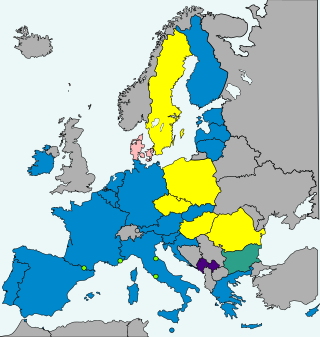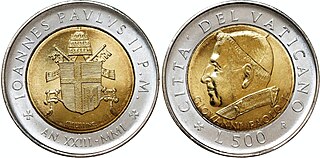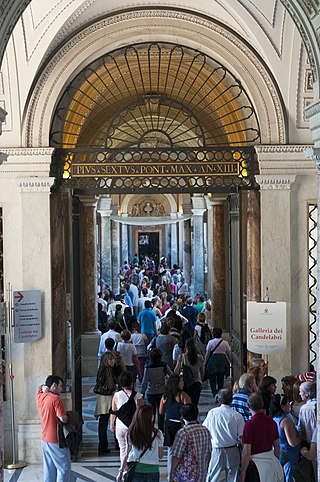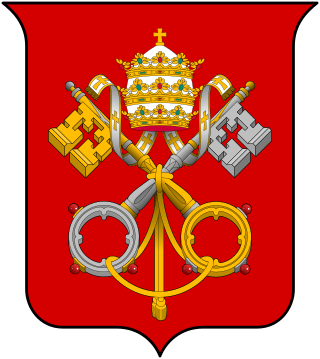This is a list of years in Vatican City . For only articles about years in Vatican City that have been written, see Category:Years in Vatican City.
 |
| This article is part of a series on |
| Vatican City |
|---|
This is a list of years in Vatican City . For only articles about years in Vatican City that have been written, see Category:Years in Vatican City.
1920s: 1929

The Holy See, also called the See of Rome, Petrine See or Apostolic See, is the jurisdiction of the Pope in his role as the bishop of Rome. It includes the apostolic episcopal see of the Diocese of Rome, which has ecclesiastical jurisdiction over the worldwide Catholic Church and sovereignty over the city-state known as the Vatican City.

Vatican City, officially the Vatican City State, is a landlocked independent country, city-state, microstate, and enclave within Rome, Italy. It became independent from Italy in 1929 with the Lateran Treaty, and it is a distinct territory under "full ownership, exclusive dominion, and sovereign authority and jurisdiction" of the Holy See, itself a sovereign entity under international law, which maintains the city-state's temporal power and governance, diplomatic, and spiritual independence. With an area of 49 hectares and as of 2023 a population of about 764, it is the smallest state in the world both by area and by population. As governed by the Holy See, Vatican City State is an ecclesiastical or sacerdotal-monarchical state ruled by the Pope, who is the bishop of Rome and head of the Catholic Church. The highest state functionaries are all Catholic clergy of various origins. After the Avignon Papacy (1309–1377) the popes have mainly resided at the Apostolic Palace within what is now Vatican City, although at times residing instead in the Quirinal Palace in Rome or elsewhere. The Vatican is also a metonym for the Holy See.

The Lateran Treaty was one component of the Lateran Pacts of 1929, agreements between the Kingdom of Italy under King Victor Emmanuel III and the Holy See under Pope Pius XI to settle the long-standing Roman Question. The treaty and associated pacts were named after the Lateran Palace where they were signed on 11 February 1929, and the Italian parliament ratified them on 7 June 1929. The treaty recognized Vatican City as an independent state under the sovereignty of the Holy See. The Italian government also agreed to give the Roman Catholic Church financial compensation for the loss of the Papal States. In 1948, the Lateran Treaty was recognized in the Constitution of Italy as regulating the relations between the state and the Catholic Church. The treaty was significantly revised in 1984, ending the status of Catholicism as the sole state religion.

The flag of Vatican City was adopted in 1929, the year Pope Pius XI signed the Lateran Treaty with Italy, creating the new independent state of Vatican City governed by the Holy See. The flag is a vertical bicolour of gold and white, with the white half charged with the coat of arms of Vatican City. It was modeled after the 1808 flag of the Papal States, a yellow-and-white bicolour defaced with the tiara and keys in the centre.

The Apostolic Palace is the official residence of the Pope, the head of the Catholic Church, located in Vatican City. It is also known as the Papal Palace, the Palace of the Vatican and the Vatican Palace. The Vatican itself refers to the building as the Palace of Sixtus V, in honor of Pope Sixtus V, who built most of the present form of the palace.

The Vatican Apostolic Library, more commonly known as the Vatican Library or informally as the Vat, is the library of the Holy See, located in Vatican City, and is the city-state's national library. It was formally established in 1475, although it is much older—it is one of the oldest libraries in the world and contains one of the most significant collections of historical texts. It has 75,000 codices from throughout history, as well as 1.1 million printed books, which include some 8,500 incunabula.

Saint Peter's Square is a large plaza located directly in front of St. Peter's Basilica in Vatican City, the papal enclave in Rome, directly west of the neighborhood (rione) of Borgo. Both the square and the basilica are named after Saint Peter, an apostle of Jesus whom Catholics consider to be the first Pope.

Vatican euro coins are issued by the Philatelic and Numismatic Office of the Vatican City State and minted by Istituto Poligrafico e Zecca dello Stato (IPZS), in Rome, Italy. The euro is the official currency of the Vatican City, although Vatican City is not a member of the Eurozone or the European Union. The euro has been the official currency of Vatican City since 2002. Before that, the Vatican lira was the official currency.
As the seat of the Papacy, the Vatican City and its predecessor, the Papal States, has played an important role in the development of Christian music. They perform chants of ancient origin, such as Gregorian chants, as well as modern polyphonic music. The papal choir is a well-known institution that dates back more than four hundred years. Singers were originally from northern Europe, but began arriving more from Spain and Italy in the 16th century. At this time, church authorities became concerned about the words of liturgical texts being drowned out by the traditional melodies. As a result, reformers like Palestrina revised the rules behind Gregorian chanting and Germanium, which were printed by the Medici Press in Rome; these reforms continued to be followed to the present day. A traditional musical instrument was the pipe organ. After the end of the Papal States, the Popes' ability to sponsor composers and musicians waned. However, it did not end entirely nor did interest in the subject. Pope Pius X and Pope Pius XII both wrote on the subject. In modern times, John Harbison and Gilbert Levine have composed or conducted for the Vatican. Although not of the Vatican, a Christmas concert where popular musicians performed had been held at the Vatican for thirteen years until ending in 2006. Notable performers at it included José Feliciano, Whitney Houston, Dionne Warwick, Gloria Gaynor, and B. B. King. The concert created controversy in 2003 due to statements by Lauryn Hill who used the opportunity to criticize the Vatican over Roman Catholic sex abuse cases.
Vatican Radio is the official broadcasting service of Vatican City.

The lira was the currency of the Vatican City between 1929 and 2002. It was not a separate currency but an issue of the Italian lira; the Banca d'Italia produced coins specifically for Vatican City.

The Vatican City national football team is the football team that represents Vatican City under the control of the Vatican Amateur Sports Association, headquartered in the Vatican's Cortile di San Damaso. The Vatican City football association was founded in 1972. Its current president is Domenico Ruggerio. Massimiliano Strapetti, an Italian, is the current head coach.

The main Tourism in Vatican City are focused in religious tourism and city tourism, including the visit to the Basilica of St. Peter, Saint Peter's Square, the Vatican Museums, the Sistine Chapel, and the Raphael Rooms.Vatican City is quarter of a square mile (0.44 km2) in area, is a popular destination for tourists, especially Catholics wishing to see the Pope or to celebrate their faith. The largest numbers of pilgrims visit Vatican City at special moments in the liturgical year, such as Christmas or Easter, or during important periods such as the proclamation of a holy year or the funeral and election of a pope.

The Pontifical Swiss Guard is an armed force and honour guard unit maintained by the Holy See that protects the Pope and the Apostolic Palace within the territory of the Vatican City State. Established in 1506 under Pope Julius II, the Pontifical Swiss Guard is among the oldest military units in continuous operation.

The following outline is provided as an overview of and introduction to Vatican City:

The Vatican Pharmacy is the only pharmacy in the Vatican City, founded in 1874 by Eusebio Ludvig Fronmen, a Fatebenefratelli religious. According to Vatican sources, it is the busiest pharmacy in the world, with 2,000 customers per day. Half of those customers come from outside the Vatican for medicines that are not available in Italy or are difficult to find.

The Diocese of Rome, also called the Vicariate of Rome, is a Latin diocese of the Catholic Church under the direct jurisdiction of the Pope, who is Bishop of Rome and hence the supreme pontiff and head of the worldwide Catholic Church. As the Holy See, the papacy is a sovereign entity with diplomatic relations, and civil jurisdiction over the Vatican City State located geographically within Rome. The Diocese of Rome is the metropolitan diocese of the province of Rome, an ecclesiastical province in Italy. According to Catholic tradition, the first bishop of Rome was Saint Peter in the first century. The incumbent since 13 March 2013 is Pope Francis.
This is an index of Vatican City–related topics.

Crime in the Vatican City consists largely of purse snatching, pick-pocketing and shoplifting perpetrated by tourists upon other tourists. The tourist foot-traffic in St. Peter's Square is one of the main locations for pickpockets in Vatican City.
The law of Vatican City State consists of many forms, the most important of which is the canon law of the Catholic Church. The organs of state are governed by the Fundamental Law of Vatican City State. The Code of Penal Procedure governs tribunals and the Lateran Treaty governs relations with the Italian Republic.